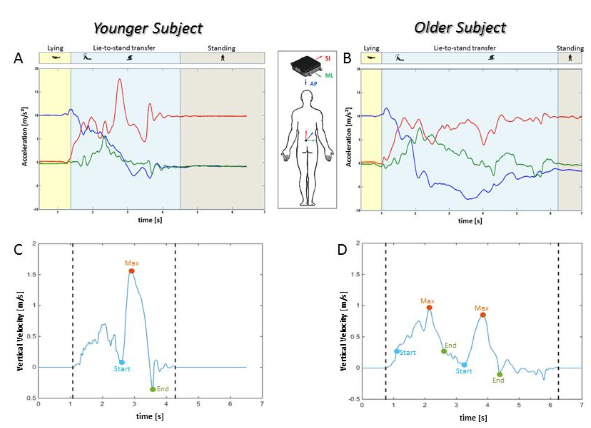Everyone is familiar with the horrific stories about older adults who are unable to get up after a fall. Getting up after a fall is indeed problematic for many older adults, which often leads them to remain incapacitated on the floor for a long time. It is a strong interest of clinicians and health-care providers to prevent these so-called “long-lies” as they can cause serious medical problems. A valuable approach to assist with the development of technologies to detect and prevent falls is to identify the act of standing up from a lying position. Kinematic analysis to objectively describe and assess standing up performance from inertial sensors is currently lacking. Hence, our main aim was to assess kinematic features during lie-to-stand transfers and describe age-related differences. In our study in Sensors, we present an easily deployable method to assess standing up based on inertial sensor signals.
Fourteen younger participants between 20 and 50 years of age, and 10 healthy older community dwellers aged 60 years and older, were asked to stand up from different initial lying postures on the floor (lying on their back, front, left and right sides). All participants were able to repeatedly stand up without help. The participants were asked to initiate the transfers voluntarily and to end the transfers in an erect standing position without considerable body movement. Kinematic data were recorded with Opal sensors (Figure 1, APDM, Portland, OR, USA) located on the sternum and lower back, which sampled 3D accelerations, angular velocity and magnetic fields at 128 Hz.

Figure 1: Lower-back tri-axial (anterior-posterior (AP), medio-lateral (ML) and superior-inferior (SI)) acceleration signal of a lie-to-stand transfer in a younger (A) and older adult (B). C and D show the correspondent vertical velocity traces, with the start and end points marking the main elevation events measured at the lower back.
Our results show that temporal and kinematic measures of transfer performance, such as duration, angular velocity, maximum vertical acceleration, maximum vertical velocity, smoothness, fluency, total rotation, were significantly different between younger and older participants. These results showed the feasibility of using body-worn sensors for the analysis of lie-to-stand movements and describe how younger and older adults stand up from the floor. This will help to better understand sensor signals of recovery after real world falls.
Understanding kinematics and different movement patterns underlying lie-to-stand transfers will help to develop autonomous technologies to detect long lies after falls and provide suitable exercise interventions for their prevention. Our results motivate further application of kinematic analysis on recovery patterns after real-world falls.
Publication:
L. Schwickert, R. Boos, J. Klenk, A. Bourke, C. Becker and W. Zijlstra (2016). Inertial Sensor Based Analysis of Lie-to-Stand Transfers in Younger and Older Adults. Sensors, online August 2016. http://www.mdpi.com/1424-8220/16/8/1277
About the Author
Lars Schwickert
Department of Clinical Gerontology at Robert-Bosch-Hospital, Stuttgart
Lars Schwickert is a research fellow at the Department of Clinical Gerontology at Robert-Bosch-Hospital in Stuttgart, Germany, working with Prof. Dr. Clemens Becker. He has a background in sports and exercise science with a medical focus, and he is currently in the final stage of his doctoral research at the Institute of Movement and Sport Gerontology of the German Sport University Cologne with Prof. Wiebren Zijlstra. His research focuses on the recovery after a fall measured with body-worn sensors.
Copyright
© 2018 by the author. Except as otherwise noted, the ISPGR blog, including its text and figures, is licensed under a Creative Commons Attribution-ShareAlike 4.0 International License. To view a copy of this license, visit https://creativecommons.org/licenses/by-sa/4.0/legalcode.
ISPGR blog (ISSN 2561-4703)
Are you interested in writing a blog post for the ISPGR website? If so, please email the ISGPR Secretariat with the following information:
- First and Last Name
- Institution/Affiliation
- Paper you will be referencing
